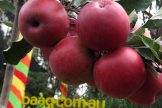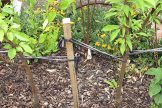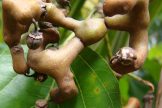
All oranges are self-fertile, small to medium evergreen trees. They have large, dark green, glossy and aromatic foliage. The pure white flowers also fill their surroundings with their characteristic scent in spring. The trees themselves grow large, but are easily kept pruned to a height and width of approx. 4 metres. All oranges prefer a sunny aspect with protection from frost. As we know, they produce juicy fruit packed with Vitamin C and are generally eaten fresh or juiced. Blood Oranges are excellent for garnishing too. Orange trees are perfect for hedging, screening, espalier, shade and as a specimen tree in any garden. Dwarf varieties can be used in pots to lend a Mediterranean feel to your courtyard garden.
We took the above picture at the wonderful Rhubarb Rhubarb Organic Grocery (Preston Market).
 Important note about plant availability. Important note about plant availability.There are hundreds of factsheets on our website provided for your information. Not all plants will be available at all times throughout the year. To confirm availability please call (03) 8850 3030 and ask for the nursery. |
Varieties
Blood Oranges
To successfully get the colouring in a blood orange the tree needs hot dry summers, cold wet winters and autumns with cold nippy nights and warm sunny days. Just the tiniest bit fussy…
Maltese – An older variety of blood orange that develops a more regular and distinct red pigmentation in hot, dry areas with cold nights. It has a sharp, sweet flavour and the small fruit has a blood red splash on the skin. The flesh is very juicy and seedy.
Arnold – Discovered by Mike Arnold in South Australia, this is a newer variety that produces a red pigmentation in coastal climates. Better colour is produced in cooler climates. The smallish fruit ripens mid-winter and has a distinctive tang. The tree is also small and bushy, making it suitable for pots or a small garden.
Cara Cara – Not a true blood orange but a naval orange producing large seedless fruit that are very sweet and low in acid. Unlike other blood oranges that produce the red pigmentation along the veins in the flesh of the fruit, the Cara flesh is all the same colour, similar to a ruby grapefruit and they get their colouration from Lycopene rather than Anthocyanin which colours a true blood orange. Temperature can alter the colour.
Tarocco – Generally regarded as the sweetest of all blood oranges. Has the highest Vitamin C of all the oranges. Skin is orange rather than red and the red pigmentation of the flesh is often contained in the lower half of the fruit. Absolutely wonderful eating orange.
Navel Oranges
Lane’s Navel (syn. Lane’s Late Navel) – Originating from Curlwwaa, NSW property of L.C. Lane. Very similar to a Washington Navel except that it colours later and is an excellent late holding navel. The tasty fruit begins to ripen in early spring and lasts until December. It has large fruit with a deep orange colour. It is easy to peel with very few seeds, much like other navels. One of the best oranges for fresh eating.
Leng Navel – This early ripening variety originated in Victoria and produces a fruit which is smaller and paler than a Washington navel. It has few seeds and a thin skin, making it a great choice for juicing.
Washington Navel – The richest and sweetest of all the oranges, the Washington navel has a low heat requirement and is the earliest to ripen (usually from May to June). It is the most popular backyard orange in Australia and is best eaten fresh. It is excellent for juicing, but must be drunk immediately as it will become bitter on standing. Oranges are medium to large, depending on the quantity of fruit set, and very sweet and juicy. Skin is relatively easy to peel and, being a navel, the fruit is seedless.
Navalina – An excellent cultivar imported from Spain in the 1980’s. Navelina has fruit which ripens around the end of April into May, making it a fantastic early season naval orange. It is sweet, seedless and juicy. Fruit can be slightly oblong in shape and naturally develops an attractive dark orange skin. The tree is compact and bushy.
Newhall Navel – The fruit is an unusual oval shape and is said to be the sweetest navel, making this variety a winner!
Toc Summer Navel – Fruit is large and very juicy with an excellent flavour. Toc Summer navel is a late holding navel and crops well into summer. For those gardeners with space, planting a Navelina, Washington and Lanes Late will find themselves harvesting Navels for up to six months of the year.
Valencia Oranges
Valencia – Has a high heat requirement, but works well in Melbourne if you leave the fruit on the tree for a long time. This makes it the last of all oranges to ripen. Leaving fruit on the tree helps to develop full flavour and sweetness. The fruit generally starts to ripen in October and can be left on the tree until the following April. Valencias require that perfect ‘hot spot’ in the garden. The fruit is large, juicy and relatively seedless, and sometimes a challenge to peel. Keeps well and produces excellent juice, second only to Navals when eaten fresh. Ripe fruit holds on the tree for months. Use tasting as your harvest guide.
Seedless Valencia – Very similar to the Valencia. The fruit ripens a little earlier but will still hang on the tree for up to 6 months. Although named seedless, this variety will produce a few seeds if pollinated by other varieties.
Sweet Oranges
Joppa – This is one of the original varieties brought here by the first fleet. Not widely grown these days, but it is an underrated backyard orange. The tree is a strong grower and produces fruit mid-winter. Oranges are medium sized, thin skinned with a good flavour and are exceptionally juicy. They have a few seeds and well worth a try. It crops consistently every year.
Mediterranean a.k.a Parramatta – This sweet orange grows on a vigorous tree and produces a medium sized fruit that contains only a few seeds. The flesh is pale and has a mild flavour. The easy to peel fruit has a pale orange skin at maturity and has the tendency to re-green.
Sour Oranges
Seville – Also called the sour or bitter orange, and once tasted you will understand why. Only really used for making jam and marmalade. It has large flattish fruit. They have a sharp bitter tang and many seeds. The fruit ripens in mid-winter. It is a strong growing tree and makes a very attractive specimen tree.
Bergamot – This tree has been grown in the Mediterranean area since the seventeenth century. The oils from the fruit peel are what make this orange famous. Oil of Bergamot is used mainly in perfume and produced throughout southern France, Italy and Paraguay. The fruit are small and smooth with a bright yellow skin when fully ripe. Similar to a Tahitian lime. You can make delicious marmalade from the skins and flesh or use the juice in place of a lemon.





